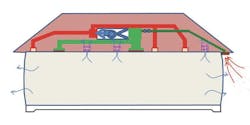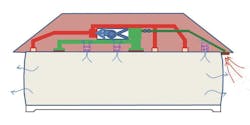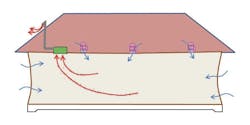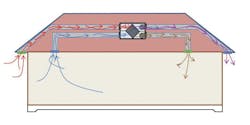Building Science: 3 Ventilation Methods for Best Indoor Air Quality
Ventilation systems do two different tasks: spot ventilation and whole-building ventilation.
Spot ventilation is for specific, non-continuous tasks such as removing moisture generated from cooking or bathing.
Whole-building ventilation provides a healthy indoor environment.
Three accepted practices are used to meet the delivered or mechanical ventilation: supply-only ventilation, exhaust-only ventilation, and balanced air ventilation. Each method is effective, but it’s crucial that the ventilation methods match the climate zone to ensure good building durability, safety, and indoor air quality. (Images courtesy Building America Solution Center).
Supply-Only Ventilation
Supply-only ventilation will create a positive pressure in the conditioned space relative to the outdoors. This strategy typically depends on building envelope leaks to remove the stale air. If a supply-only ventilation system is drawing 80 cfm of outdoor air into the home while the air handler is operating, then at the same time 80 cfm must be exiting the building somewhere. That “somewhere” is the many leaks in the building envelope between indoors and outdoors.
In humid climates where the conditioned indoor air is dryer than the outdoor air, this can be a good strategy. It will help keep building envelope materials dry while providing ventilation air that is both filtered and dehumidified. In cold, dry climates where indoor air is more humid than the outdoor air (in high-performance buildings), supply-only ventilation would be a poor strategy.
Exhaust-Only Ventilation
Exhaust-only ventilation is the reverse of supply-only ventilation: stale air leaves the building from a known location (through exhaust fans ducted to the outdoors) and outdoor air enters the building from an unknown location. For every cubic foot of air exhausted out of the building, a cubic foot of air has to come into the building from somewhere. Again, that “somewhere” is the many air leaks in the building envelope that connect the conditioned space to unconditioned space or directly to the outdoors. With this strategy, the outdoor air entering the building is neither filtered nor conditioned. The target ventilation rate is met by operating a quiet exhaust fan at a specific flow rate for a scheduled runtime each hour.
This strategy works well in cold, dry climates because the air outdoors is generally drier than the air indoors (in tightly built homes). Unlike older, leaky homes, newer high-performance homes are built to be more airtight. They tend to accumulate more moisture—water vapor in the indoor air comes from cooking, bathing, and clothes washing. Exhaust-only ventilation is needed to safely remove this moisture before condensation becomes an issue.
Make-up air moving through the envelope helps to keep building materials dry in cold, dry climates. Exhaust-only ventilation would be a poor strategy in humid climates, where water vapor outdoors is typically higher than indoors. Heat recovery ventilators and energy recovery ventilators provide balanced ventilation throughout the home. They can be set to operate continuously without the energy penalties associated with regular exhaust fans because they have a heat exchanger that transfers heat between outgoing and incoming air streams.
Balanced Ventilation
Balanced ventilation is designed to provide both supply and exhaust. The best means for providing this balanced system is with a heat recovery ventilator (HRV) or an energy (or enthalpy) recovery ventilator (ERV). Both provide a controlled way of ventilating a home while minimizing energy loss because they incorporate a heat exchanger that uses conditioned air from the outgoing exhaust air to pre-condition the fresh incoming air. The heat exchanger transfers heat but does not allow the intermingling of outgoing and incoming air.
Here, incoming and outgoing air volumes are balanced and air is evenly distributed throughout the house. These are whole-house systems; they can share the central furnace’s air handler and duct system or have their own duct system.
The main difference between an HRV and an ERV is the way the heat exchanger works. With an ERV, the heat exchanger transfers water vapor along with heat energy, while an HRV only transfers heat. See the manufacturers’ specifications for determining which model is best in which climate and install it according to the directions for best performance, especially in regard to ERVs in humid climates. Research shows that most ERVs can recover about 70 to 80 percent of the sensible energy in the exiting air. In summer, ERVs seem to perform best during peak outdoor conditions and lose efficiency during low-temperature, high-humidity conditions.
The ventilation information contained in this article is a product of the Building America Solution Center, which provides building-science–based knowledge on a variety of residential design and construction topics for new and existing homes. Additional guidance on selecting, designing, and installing ventilation systems, can be found here at the U.S. Department of Energy's website.




